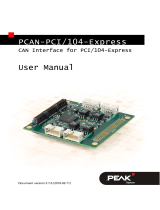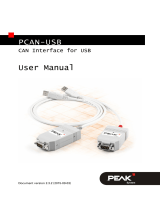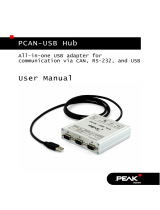Page is loading ...

PCAN-miniPCIe FD
CAN FD Interface for PCI Express Mini
(PCIe)
User Manual
Document version 1.2.0 (2019-11-06)

PCAN-miniPCIe FD – User Manual
2
Relevant products
Product name Model Part number
PCAN-miniPCIe FD Single
Channel
One CAN channel, galvanic
isolation for CAN connection
IPEH-004045
PCAN-miniPCIe FD Dual
Channel
Two CAN channels, galvanic
isolation for CAN connections
IPEH-004046
PCAN-miniPCIe FD Four
Channel
Four CAN channels, galvanic
isolation for CAN connections
IEPH-004047
The cover picture shows the product PCAN-miniPCIe FD Dual and Four Channel. The
Single Channel model has an identical form factor like the Dual Channel version but
varies in equipment.
PCAN is a registered trademark of PEAK-System Technik GmbH. CANopen® and
C
iA® are registered community trade marks of CAN in Automation e.V.
All other product names in this document may be the trademarks or registered trade-
marks of their respective companies. They are not explicitly marked by ™ or ®.
Copyright © 2019 PEAK-System Technik GmbH
Duplication (copying, printing, or other forms) and the electronic distribution of this
document is only allowed with explicit permission of PEAK-System Technik GmbH.
PEAK-System Technik GmbH reserves the right to change technical data without
prior announcement. The general business conditions and the regulations of the
license agreement apply. All rights are reserved.
PEAK-System Technik GmbH
Otto-Roehm-Strasse 69
64293 Darmstadt
Germany
Phone: +49 (0)6151 8173-20
Fax: +49 (0)6151 8173-29
www.peak-system.com
info@peak-system.com
Doc
ument version 1.2.0 (2019-11-06)

PCAN-miniPCIe FD – User Manual
3
Contents
1 Introduction 5
1.1 Properties at a Glance 5
1.2 System Requirements 7
1.3 Scope of Supply 7
2 Installing the Software and the Card 8
3 Connecting the CAN Bus 10
3.1 Connection over D-Sub Connector 10
3.2 Daisy Chain 12
3.3 Internal Termination 12
3.4 Cabling 13
3.4.1 Termination 13
3.4.2 Example of a Connection 13
3.4.3 Maximum Bus Length 14
4 Software and API 15
4.1 Monitor Software PCAN-View 15
4.1.1 Receive/Transmit Tab 18
4.1.2 Trace Tab 20
4.1.3 PCAN-miniPCIe FD Tab 21
4.1.4 Bus Load Tab 22
4.1.5 Error Generator Tab 23
4.1.6 Status Bar 24
4.2 Linking Own Programs with PCAN-Basic Version
4 or Higher 25
4.2.1 Features of PCAN-Basic 26
4.2.2 Principle Description of the API 27
4.2.3 Notes about the License 28
5 Technical Specifications 29

PCAN-miniPCIe FD – User Manual
5
1 Introduction
The PCAN-miniPCIe FD is a CAN interface for the PCI Express Mini
slot. With its space-saving format, the plug-in card is a suitable
solution for connecting embedded systems to up to four CAN FD
and CAN networks. There is galvanic isolation of up to 300 Volts
between the computer and CAN sides. The card is available as a
single, dual, or four-channel version.
The new CAN FD standard (CAN with Flexible Data rate) is primarily
characterized by higher bandwidth for data transfer. The maximum
of 64 data bytes per CAN FD frame (instead of 8 so far) can be
transmitted with bit rates up to 12 Mbit/s. CAN FD is downward-
compatible to the CAN 2.0 A/B standard, thus CAN FD nodes can be
used in existing CAN networks. However, in this case the CAN FD
extensions are not applicable.
The monitor software PCAN-View and the programming interface
PCAN-Basic for the development of applications with CAN
connection are included in the scope of supply and support the new
standard CAN FD.
Tip: At the end of this manual (Appendix C) you can find a
Quick Reference with brief information about the installation
and operation of the PCAN-miniPCIe card.
1.1 Properties at a Glance
CAN interface for the PCI Express Mini slot
1, 2, or 4 High-speed CAN channels (ISO 11898-2)
Form factor PCI Express Mini (only for single and dual channel
versions due to the height of the four-channel version)

PCAN-miniPCIe FD – User Manual
6
Complies with CAN specifications 2.0 A/B and FD
CAN FD support for ISO and Non-ISO standards switchable
CAN FD bit rates for the data field (64 bytes max.) from 25 kbit/s
up to 12 Mbit/s
CAN bit rates from 25 kbit/s up to 1 Mbit/s
CAN bus connection via connection cable and D-Sub, 9-pin (in
accordance with CiA® 303 -1)
FPGA implementation of the CAN FD controller
NXP TJA1044GT CAN transceiver
Galvanic isolation on the CAN connection up to 300 V, separate
for each CAN channel
CAN termination can be activated through a solder jumper,
separately for each CAN channel
Measurement of bus load including error frames and overload
frames on the physical bus
Induced error generation for incoming and outgoing CAN
messages
Extended operating temperature range from -40 to 85 °C
(-40 to 185 °F)
Note: This manual describes the use of the PCAN-miniPCIe card
with Windows. You can find device drivers for Linux and the
corresponding application information on the provided DVD in
the Develop directory branch and on our website under
www.peak-system.com/linux.

PCAN-miniPCIe FD – User Manual
7
1.2 System Requirements
A vacant PCI Express Mini slot in the computer (specification 1.x)
Operating system Windows 10, 8.1, 7 (32/64-bit)
or Linux (32/64-bit)
1.3 Scope of Supply
PCAN-miniPCIe FD card
Connection cable including D-Sub plug for each channel
Device drivers for Windows 10, 8.1, 7 and Linux (32/64-bit)
CAN monitor PCAN-View for Windows
Programming interface PCAN-Basic for developing applications
with CAN connection
Programming interfaces for standardized protocols from the
automotive sector
Manual in PDF format

PCAN-miniPCIe FD – User Manual
8
2 Installing the Software and
the Card
This chapter covers the software setup for the PCAN-miniPCIe FD
card in Windows and the installation of the card in the computer.
Install the driver before
you install the card.
Do the following to install the driver:
1. Start Intro.exe from the supplied DVD.
The navigation program starts.
2. In the main menu, select Drivers and click on Install now.
3. Confirm the message of the User Account Control related to
"Installer database of PEAK Drivers".
The driver setup starts.
4. Follow the program instructions.
Do the following to install the card:
Attention! Electrostatic discharge (ESD) can damage or destroy
components on the card. Take precautions to avoid ESD.
1. Shut down the computer.
2. Disconnect the computer’s power supply.
3. Open the computer case.
4. Insert the PCAN-miniPCIe FD card into an empty PCI Express
Mini slot.
5. For each CAN channel, mount a D-Sub connector with
connection circuit board into a respective hole of the
computer casing.

PCAN-miniPCIe FD – User Manual
9
6. For each CAN channel interconnect a D-Sub connector and
the corresponding port on the PCAN-miniPCIe FD card.
7. Close the computer case.
8. Reconnect the computer power supply.
9. Turn on the computer and start Windows.
Windows detects the new hardware and completes the driver
installation.
Do the following to check the operational readiness:
1. Open the Windows Start menu.
2. Type peakcpl and press Enter .
The information window for PEAK hardware appears. The plug-in
card must be displayed in the table on the CAN Hardware tab.

PCAN-miniPCIe FD – User Manual
10
3 Connecting the CAN Bus
3.1 Connection over D-Sub Connector
A High-speed CAN bus (ISO 11898-2) is connected to the 9-pin
D-Sub connector. The pin assignment for CAN corresponds to the
specification CiA® 303-1.
Figure 1: Positions of the CAN ports on the PCAN-miniPCIe FD card;
left four-channel and right two-channel card;
for the single channel card only CAN 1 is present
Figure 2: Pin assignment of High-speed CAN;
male connector on the card (IPEH-004045/46/47)

PCAN-miniPCIe FD – User Manual
11
Figure 3: PCAN-miniPCIe FD Four Channel card with connection cables
To connect a CAN bus to the PCAN-miniPCIe FD card, use the
supplied special connection cables. After you've plugged in the
cable on the card, you can connect a CAN bus to the D-sub socket.
The pin assignment between the D-Sub port and the 4-pin connector
1
on the PCAN-miniPCIe FD card is as follows:
Figure 4: Front view of a CAN connector (SUR)
on the PCAN-miniPCIe FD card (CAN 1 to 4)
1
Connector type SUR from JST (www.jst-mfg.com),
name of the matching plug: SM05B-SUR-TF

PCAN-miniPCIe FD – User Manual
12
Pin SUR Function Pin D-Sub
1 Not connected -
2 Not connected -
3 GND 3, 6
4 CAN_H 7
5 CAN_L 2
3.2 Daisy Chain
The daisy chain can be activated via solder jumpers on the board to
connect a CAN FD optimized connection to an existing CAN bus.
This makes interference-free operation possible at higher CAN FD
bit rates, because stubs and Y distributions are largely avoided.
Important Note: The activation of the daisy chain is optional.
The manual is available on request from our customer support.
Please contact support@peak-system.com.
3.3 Internal Termination
The internal termination can be activated by solder jumpers on the
board to terminate one end of the CAN bus with 120 Ohms. At
delivery the termination is not activated. A High-speed CAN bus
(ISO 11898-2) must be terminated on both ends with 120 Ohms.
Otherwise disturbances may arise.
Important Note: The activation of the internal termination is
optional. The manual is available on request from our customer
support. Please contact support@peak-system.com.
Tip: We recommend to do termination at the CAN cabling, for
example with termination adapters (e.g. PCAN-Term). Thus,
CAN nodes can be flexibly connected to the bus.

PCAN-miniPCIe FD – User Manual
13
3.4 Cabling
3.4.1 Termination
The High-speed CAN bus (ISO 11898-2) must be terminated with
120 ohms at both ends. The termination prevents interfering signal
reflections and ensures the proper operation of the transceivers of
the connected CAN nodes (CAN interfaces, control devices).
The PCAN-miniPCIe FD card has an optional internal termination
with 120 ohms (see chapter 3.3).
3
.4.2 Example of a Connection
Figure 5: Simple CAN connection
This example shows a connection between the PCAN-miniPCIe FD
card and a control unit. The connection cable is terminated with 120
ohms at both ends.

PCAN-miniPCIe FD – User Manual
14
3.4.3 Maximum Bus Length
High-speed CAN networks have bit rates up to 1 Mbit/s. The
maximum bus length primarily depends on the bit rate.
The following table shows different maximum possible CAN bus
length with different bit rates:
Bit rate Bus length
1 Mbit/s 40 m
500 kbit/s 110 m
250 kbit/s 240 m
125 kbit/s 500 m
50 kbit/s 1.3 km
20 kbit/s 3.3 km
10 kbit/s 6.6 km
5 kbit/s 13.0 km
The listed values have been calculated on the basis of an idealized
system and can differ from reality.
Note: For CAN FD, the same maximum bus lengths apply as for
CAN, despite the higher data bit rate of CAN FD.
The dependency is based on the bit rate during the arbitration,
called nominal bit rate. The nominal bite rate at CAN FD can be
up to 1 Mbit/s.

PCAN-miniPCIe FD – User Manual
15
4 Software and API
This chapter covers the provided software PCAN-View and the
programming interface PCAN-Basic.
4.1 Monitor Software PCAN-View
PCAN-View is simple Windows software for viewing, transmitting,
and logging CAN and CAN FD messages.
Note: This chapter describes the use of PCAN-View with a
CAN FD card.
Figure 6: PCAN-View for Windows

PCAN-miniPCIe FD – User Manual
16
Do the following to start and initialize PCAN-View:
1. Open the Windows Start menu and select PCAN-View.
The Connect dialog box appears.
Figure 7: Selection of the hardware and parameters
2. Select an interface from the list.
3. From the drop-down menu, choose a Clock Frequency. The
selectable bit rates in the following are based on this
setting.
4. From the drop-down list, select a Nominal Bit rate, which is
used for the arbitration phase (max. 1Mbit/s).
5. Enable the Data Bit Rate checkbox.
6. From the drop-down menu, choose an additional
Data Bit rate for the CAN FD bus. The bit rate selected here
is used to transfer the data fields of a CAN FD frame with a
higher bit rate.
Note: Both transmission rates must match those which are
used by all nodes on the CAN bus.
Tip: Create custom bit rates by using the arrow button ().

PCAN-miniPCIe FD – User Manual
17
7. Under Filter settings, you can limit the range of CAN IDs to
be received, either for standard frames (11-bit IDs) or for
extended frames (29-bit IDs).
8. Activate the Listen-only mode if you do not actively
participate in the CAN traffic and just want to observe. This
also avoids an unintended disruption of an unknown CAN
environment (e.g. due to different bit rates).
9. Confirm the settings in the dialog box with OK. The main
window of PCAN-View appears (see Figure 8)

PCAN-miniPCIe FD – User Manual
18
4.1.1 Receive/Transmit Tab
Figure 8: Receive/Transmit tab
The Receive/Transmit tab is the main element of PCAN-View. It
contains two lists, one for received messages and one for the
transmit messages. The CAN data format is hexadecimal by default.
Do the following to transmit one CAN message with PCAN-View:
1. Select the menu command Transmit > New Message
(alternatively or Ins ).
The New Transmit Message dialog box appears.
Figure 9: Dialog box New Transmit Message

PCAN-miniPCIe FD – User Manual
19
2. Enable the CAN FD checkbox to define a CAN FD message
with a maximum Length of 64 data bytes.
3. Enter the ID, the data Length, and the CAN message Data.
With a length of more than 8 bytes, click on
and enter the
data bytes into the editor.
Note: With the program version 4 of PCAN-View, the DLC field
was renamed to Length. Latter reflects the actual data length.
4. Enter a value into the Cycle Time field to choose manually
or periodically message transmission. Enter a value greater
than 0 to transmit periodically. Enter the value 0 to transmit
only manually.
5. Enable the Bit Rate Switch checkbox, that the data of a CAN
FD message is transmitted with the selected Data Bit Rate.
6. Confirm the entries with OK.
The created transmit message appears on the
Receive/Transmit tab.
7. Trigger selected transmit messages manually with the menu
command Transmit > Send (alternatively Space bar). The
manual transmission for CAN messages being transmitted
periodically is carried out additionally.
Tip: Under the menu command File > Save, you can save the
current transmit messages into a transmit list. Saved transmit
lists are available for reuse.

PCAN-miniPCIe FD – User Manual
20
4.1.2 Trace Tab
Figure 10: Trace tab
On the Trace tab, the data tracer (data logger) of PCAN-View is used
for logging the communication on a CAN bus. During this process
the messages are cached in the working memory of the PC.
Afterwards they can be saved to a file.
The Tracer runs either in linear or in ring buffer mode. The linear
buffer mode stops the Tracer as soon as the buffer is full. The ring
buffer mode overwrites the oldest messages by new ones as soon
as the buffer is full.
/







